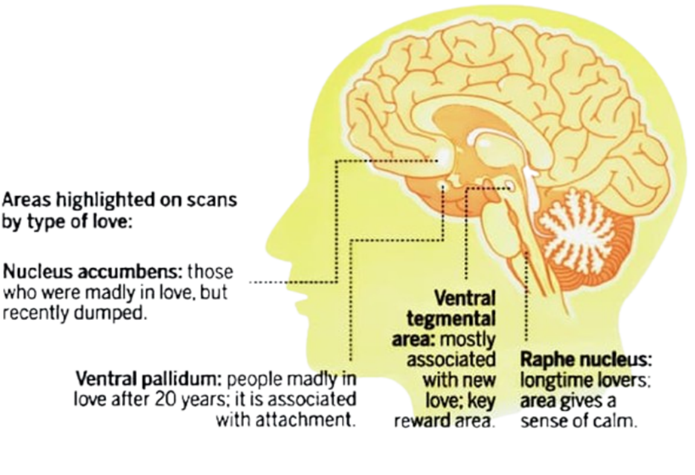Romantic bonding and relationship represents a complex neurobiological phenomenon encompassing behavioural and emotional adaptations crucial for survival and reproduction. This systematic review examines the neurochemical foundations of love, revealing it as an emergent property arising from intricate interactions between various neurotransmitters and neuropeptides. Our analysis demonstrates that romantic love comprises three distinct yet interconnected neural processes: lust, attraction, and attachment. Each process operates through specific neurotransmitter systems and neural circuits that mutually reinforce one another. Sexual desire, primarily regulated by testosterone and estrogen, prominently involves the amygdala. The attraction phase engages the brain's reward and stress response systems, with dopamine, norepinephrine, cortisol, and serotonin playing crucial roles, primarily mediated through the nucleus accumbens and ventral tegmental area. This understanding of love's neurobiological basis provides insights into human pair-bonding mechanisms and potential therapeutic applications in relationship-related disorders.
Neurobiological mechanisms, Romantic attachment, Neurotransmitter systems, Sexual desire, Pair-bonding, Neural circuits.
Evolutionary biology frames romantic love as an adaptive mechanism promoting survival and reproduction through modified emotional and behavioural patterns. The scientific question centers on whether these evolutionarily-shaped behaviours have measurable biological correlates in brain activation and hormonal responses. Research reveals several key neurobiological components of romantic love. The dopaminergic reward system, particularly the ventral tegmental area and nucleus accumbens, shows increased activation during early-stage romantic love, similar to reward-seeking behaviours. This system interacts with oxytocin and vasopressin, neuropeptides crucial for pair-bonding and attachment formation. Neuroimaging studies demonstrate consistent activation patterns in individuals viewing photos of romantic partners. These include increased activity in the caudate nucleus and ventral tegmental area, regions associated with motivation and reward processing. Simultaneously, areas linked to negative emotions and social judgment show reduced activation, potentially explaining the idealization of romantic partners. The hormonal profile of romantic love includes elevated levels of norepinephrine, leading to increased attention and memory formation, and reduced serotonin levels, similar to patterns observed in obsessive-compulsive disorder. This may explain the intense focus on romantic partners and intrusive thinking characteristic of early-stage love. Testosterone levels typically decrease in men during pair-bonding, potentially promoting monogamy and parental investment. Cortisol levels often increase during early romantic love, reflecting the stress response to novel social bonding. These hormonal changes facilitate behavioural adaptations supporting long-term pair-bonds. The neurobiology of romantic love shows remarkable consistency across cultures, suggesting evolutionary conservation of these mechanisms. This biological foundation helps explain universal features of romantic love while acknowledging individual and cultural variations in its expression.Understanding these neurobiological mechanisms provides insight into both normal romantic attachment and pathological conditions affecting romantic relationships. This knowledge may inform therapeutic approaches for relationship-related psychological disorders and the development of treatments for conditions affecting social bonding. This contemporary scientific understanding frames romantic love not merely as a cultural construct but as a complex biological phenomenon with clear evolutionary advantages for human reproduction and survival [1-3].
The Neurobiological Framework of Affection
Love, while deeply explored through artistic and philosophical lenses, can be understood through a neurobiological framework. At its core, love emerges from complex interactions between specific brain chemicals. This biological orchestra involves neuropeptides - small protein-like molecules used by neurons to communicate - and neurotransmitters that serve as chemical messengers in the brain. The neurochemical basis of love involves several key players: oxytocin, often called the "bonding hormone," facilitates social attachment and trust; vasopressin contributes to long-term bonding and territorial behaviour; and dopamine creates motivation and reward sensations. These molecules work in concert with other neurotransmitters like serotonin, which influences mood regulation and sexual behaviour. This chemical interplay produces measurable physiological and behavioural responses: elevated heart rate, emotional attachment, increased empathy, and partner-specific preferences. The evolutionary advantage of these neurochemical systems lies in their ability to promote pair bonding, parental care, and social cohesion - all crucial for species survival. Understanding love through this molecular lens doesn't diminish its significance; rather, it provides insight into how our bodies create and maintain deep emotional connections. This biological perspective helps explain why love influences behaviour so profoundly and why it remains a fundamental aspect of human experience across cultures. The complexity of these neural mechanisms suggests that love isn't simply a basic emotion but rather an emergent phenomenon - a higher-order property arising from the synchronized activity of multiple neurochemical systems. This scientific framework offers a complementary perspective to cultural and philosophical interpretations of love, enriching our understanding of this vital human experience [4-6].
The Neurobiology of Romantic Bonding: Distinguishing Sexual and Emotional Bonding Mechanisms
While sexual drive and courtship are deeply connected, research suggests these are separate but complementary neurobiological systems. Romantic love manifests universally across cultures through specific physiological and behavioral patterns that parallel mammalian courtship behaviours, including heightened energy, focused attention, and mate-guarding. The progression of human romantic love typically begins with idealization, where one individual perceives another as uniquely special. This triggers a cascade of psychological responses: intense focus, amplification of positive traits, and minimization of flaws. The emotional state fluctuates between euphoria during positive interactions and deep distress during conflicts or separation. Key characteristics include emotional dependency, heightened empathy, self-sacrificing behaviour, and persistent thoughts about the partner. While sexual desire and possessiveness are present, the emotional connection typically takes precedence. Rejection activates a predictable sequence of emotional responses: protest, anger, and eventually resignation. These patterns suggest love operates through distinct neuroendocrine pathways that influence behaviour and emotional conditioning [7-9].
Romantic Relationship as a Motivation System: Neurobiological Evidence and Evolutionary Perspectives
Love transcends traditional emotional classification, functioning instead as a complex motivation system geared towards establishing and maintaining pair bonds. Neuroimaging studies using functional MRI reveal activation patterns in brain regions associated with goal-directed behaviour and motivation, supporting this framework. This perspective aligns with evolutionary biology, as successful mate selection and retention directly impact reproductive fitness. The intensity of love as a motivational force becomes evident when comparing it to sexual drive. While sexual rejection rarely leads to extreme behaviours, love rejection can trigger severe psychological and behavioural responses, including stalking, self-harm, or depression. This disproportionate impact suggests love's deeper role in human survival and reproduction.The motivation system comprises three distinct yet interrelated components like, lust serves as the basic reproductive drive, encouraging mating with suitable partners through hormonal regulation by testosterone and estrogen, primarily mediated through the amygdala. Attraction functions as an efficiency mechanism, focusing attention on specific individuals who may represent optimal genetic matches. This process involves dopamine, norepinephrine, and serotonin pathways, particularly in the ventral tegmental area and nucleus accumbens. Attachment enables long-term bonding crucial for offspring survival. This component relies on vasopressin and oxytocin, operating through the ventral pallium and raphe nucleus. These neurobiological systems work in concert, creating a sophisticated motivation network that evolved to optimize mate selection, pair bonding, and reproductive success. Understanding love as a motivation system rather than an emotion provides a more accurate framework for studying its biological basis and evolutionary significance. This reconceptualization helps explain love's powerful influence on behaviour, decision-making, and survival strategies in human populations. The motivation system model accounts for both the intense drive to establish romantic relationships and the severe psychological impact when these bonds are threatened or broken [10-12].
Neurobiological Mechanisms of Early-Stage Romantic Bonding: A Stress-Reward Interface
The initial phase of romantic love presents a fascinating neurobiological paradox, characterized by heightened stress responses that ultimately facilitate social bonding and attachment. This biological state differs markedly from later relationship phases through distinct physiological mechanisms. Stress serves as a primary catalyst in seeking romantic connection. Moderate stress levels promote social interaction through the hypothalamic-pituitary-adrenal (HPA) axis activation. Individuals experiencing romantic love show elevated cortisol levels compared to non-romantic controls. This "love-induced hypercortisolemia" may represent either an adaptation to relationship-induced changes or an arousal state that helps overcome fear of novel social situations. The noradrenergic system plays a crucial role in early romantic love. Increased central norepinephrine activity produces characteristic symptoms: heightened alertness, reduced sleep and appetite, enhanced attention, and improved memory formation for new stimuli. The peripheral sympathetic effects of norepinephrine manifest as increased heart rate, sweating, and trembling - common physical manifestations of romantic attraction. The stress-reward interface in romantic love involves oxytocin (OT), which mediates positive social interactions and pair bonding. The initial anxiety inherent in early romantic love appears to find resolution through relationship-induced comfort, facilitated by complex interactions between stress response and reward pathways. The serotonergic system, particularly through amygdalar pathways, interacts with oxytocin. Research demonstrates that oxytocin administration reduces anxiety by suppressing amygdala activity.This neurobiological framework suggests that early romantic love represents a unique physiological state where stress responses paradoxically drive social bonding. The interaction between stress hormones, neurotransmitters, and neuropeptides creates a dynamic biological environment that promotes attachment formation while simultaneously generating the characteristic emotional and physical manifestations of romantic love. This complex interplay between stress and reward systems helps explain why early romantic love often feels simultaneously anxiety-provoking and pleasurable, demonstrating nature's elegant solution for promoting human pair bonding through neurobiological mechanisms [13-15].
Neuroendocrine Basis of Love: Hormonal and Gender-Specific Neural Mechanisms
Gonadal hormones play a supportive but secondary role in the neurobiological mechanisms of love and attachment. While sex hormones can influence the development of social attachment neural circuits, they are not essential for forming emotional bonds. Testosterone acts through hypothalamic receptors to potentially decrease serotonin activity, increasing aggressive behaviors. It also elevates vasopressin levels in key brain regions like the medial amygdala, lateral hypothalamus, and pre-optical medial area - areas linked to aggressive responses. The relationship between gonadal hormones and social attachment involves indirect regulation of oxytocin and vasopressin systems. However, the fact that social bonds can form without gonadal steroids present indicates these hormones are just one component in love's complex neurobiological framework. Neuroimaging studies have revealed distinct gender differences in early romantic love and partner preference. Male subjects show enhanced activation in the right posterior dorsal insula, correlating with arousal responses and facial attraction processing. They also display increased activity in visual integration centers. In contrast, female subjects demonstrate greater activation in neural regions associated with attention, memory formation, and emotional processing.These biological differences align with evolutionary mate selection strategies. Men demonstrate stronger neural responses to visual cues signalling youth and physical attractiveness. Women show heightened neural activation patterns when evaluating potential mates' social status and resource availability. These gender-specific neural responses likely reflect evolutionary adaptations in mate selection criteria. This scientific understanding of love's biological basis demonstrates how hormonal systems, neural circuits, and evolutionary pressures interact to influence human romantic behaviour and attachment formation [16-18].
Neurobiological Foundations of Pair Bonding: From Prairie Voles to Human Relationships
Pair bonding, characterized by enduring preferential associations between sexually mature adults, represents a rare evolutionary adaptation observed in less than 5% of mammalian species. This phenomenon encompasses selective contact, affiliation, and sexual exclusivity with a chosen partner, accompanied by mate guarding and shared parental care behaviours.The evolution of pair bonding likely emerged as an adaptive response to offspring requiring extensive biparental care. This adaptation provides mutual benefits: in humans, married individuals consistently demonstrate longer lifespans across demographic groups, while high intimacy levels correlate with enhanced immune function, improved cardiovascular health, and reduced depression rates.The prairie vole (Microtus ochrogaster) has emerged as a crucial model organism for understanding pair bonding mechanisms. Native to resource-scarce central United States grasslands, these rodents exhibit strict social monogamy, maintaining lifelong partnerships until partner death. Male prairie voles display distinctive behavioral patterns, including enhanced paternal care, territorial defense against conspecifics, and sustained care for multiple litter generations.The neurobiological underpinnings of pair bonding involve three key neurotransmitters namely, arginine vasopressin (AVP), oxytocin (OT), and dopamine. While monogamous and polygamous vole species share similar neural distributions of AVP and OT, they exhibit marked differences in receptor distribution patterns (V1aR and OTR) and densities. These variations appear linked to promoter region polymorphisms, with potential epigenetic modifications of the OTR also playing a role. Specific neural mechanisms facilitate pair bond formation. In male prairie voles, mating-induced cohabitation increases AVP synthesis in the bed nucleus of the stria terminalis and enhances limbic system AVP release. Female voles show chemosensory-induced alterations in OTR density within the accessory olfactory bulb. OT and vasopressin receptor activation in these regions appears crucial for developing conditioned partner preference, with OTR antagonism particularly disrupting female pair bonding.Comparative studies in other species provide additional insights. In zebra finches, VP knockdown in the hypothalamic paraventricular nucleus produces sex-specific behavioral changes, affecting aggression and social bonding. Human studies have identified analogous vasopressin receptor polymorphisms influencing pair bonding behaviour. The ventral palladium emerges as a critical region for pair bond formation, requiring V1aR activation. Similarly, oxytocin activity in the nucleus accumbens contributes to partner preference development. Human neuroimaging studies of long-term partners reveal activation patterns in the ventral palladium/putamen, anterior cingulate cortex, and mid-insular cortex, regions corresponding to prairie vole V1aR distribution patterns. Notably, neural circuits for romantic attachment partially overlap with those governing maternal love, sharing activation in the medial insula, anterior cingulate gyrus, and caudate nucleus. However, maternal love engages distinct regions, including the lateral orbitofrontal cortex, while both systems involve areas rich in OT and AVP receptors [19-22].
Neural Mechanisms of Romantic Bonding: Distinguishing Features from Addiction through Reward Pathways
The neurobiology of romantic love involves brain reward centers, sharing some similarities with addiction pathways while maintaining key differences. Unlike drug addiction, love employs natural feedback mechanisms that limit destructive behaviours through aversion center activation. Brain imaging studies reveal that love activates specific reward regions, reducing emotional judgment, fear, and depression while enhancing mood and decreasing critical social assessment. This activation pattern demonstrates love's dual effect: suppressing negative emotion/avoidance centers while stimulating pleasure and reward mechanisms.The reward circuitry involved in pair bonding heavily depends on oxytocin (OT) and vasopressin (AVP) receptor activation. Dopamine (DA), particularly in the mesolimbic system, plays a central role in maintaining romantic attachments. Both D1 and D2 receptors show significant expression in the nucleus accumbens, while D3-5 receptors appear in the limbic system's amygdala and hippocampus, contributing to reward and motivation processes. fMRI studies using partner photographs demonstrate activation of the ventral tegmental area (VTA), a key reward center associated with pleasure, arousal, and reward-seeking behaviour. The VTA connects to the caudate nucleus, facilitating reward detection and goal representation. These patterns persist in both early intense love (~7 months) and established relationships (~29 months), though with varying intensities [23-27].

Sexual activity plays a pivotal role in reinforcing the brain's reward system, which in turn strengthens emotional attachment. Elevated levels of testosterone and estrogen enhance dopamine (DA) release, while increased activity in dopaminergic pathways reciprocally promotes the secretion of these hormones. However, the interaction between DA reward systems and these mechanisms appears weaker in certain non-human species. Research highlights the intricate interplay between gonadal hormones and neural reward systems, underscoring distinct but overlapping pathways that mediate love and sexual behaviour. These systems collectively differentiate romantic love from platonic forms of attachment, such as friendship or maternal bonds.
In humans, sexual activity transcends reproductive purposes, occurring throughout the menstrual cycle, potentially enhancing pair bonding. Unlike many species, human females exhibit permanently enlarged mammary glands, independent of lactation. Breast and nipple stimulation, integral to human sexual interactions, trigger the release of oxytocin (OT), a hormone strongly associated with bonding. During orgasm, OT levels rise in women, while vasopressin (AVP) levels increase in men, further validating the role of sexual activity in strengthening emotional connections. In the postpartum period, sexual desire often diminishes, likely as a reproductive strategy mediated by OT’s activation of reward centers in the ventral tegmental area (VTA). The interplay between neuroendocrine systems for sexual attraction and partner attachment is particularly evident in monogamous species. These systems motivate individuals to prefer specific mates and establish lasting bonds. In contrast, non-monogamous species exhibit independent mechanisms for attraction and attachment. Humans, as a predominantly monogamous species, showcase complex, adaptable, and interdependent neuroendocrine networks that balance emotional, behavioural, and reproductive strategies. The relationship between central DA activity, sex steroids, and sexual arousal is evolutionarily conserved, with the sympathetic nervous system also contributing to these processes. Behavioural evidence suggests distinct pathways for love and sexual drive. While sexual desire may encompass multiple potential partners, romantic love is typically directed toward one individual. Sexual desire is satiable, whereas love persists over time, ensuring sustained emotional bonds. This distinction enables humans to efficiently allocate energy toward forming and maintaining long-term partnerships. Additionally, reward pathways involving hippocampal mechanisms and the ventral pallidum (VP) underscore the integration of attachment and pleasure. In monogamous species, sexual activity stimulates OT in the nucleus accumbens (NA) and AVP in the VP, enhancing DA release in reward regions. These neurochemical interactions motivate attachment to a specific mate, fostering pair bonding. Conversely, in promiscuous species, the pleasurable aspects of mating are not associated with a particular partner, preventing long-term attachments. Thus, the neuroendocrine systems governing sexual behaviour and emotional bonding operate synergistically, facilitating species-specific reproductive strategies while highlighting the evolutionary complexity of human relationships [28-31].
Table No. 1: Neurobiological Framework of Affection


 Arnab Roy* 2
Arnab Roy* 2
 Meghna Singh 1
Meghna Singh 1
 Aniruddha Basak 3
Aniruddha Basak 3
 Ritesh Kumar 3
Ritesh Kumar 3
 Adarsh Kumar 4
Adarsh Kumar 4
 Akash Bhattacharjee 4
Akash Bhattacharjee 4
 Ayesha Memon 4
Ayesha Memon 4
 Navneet Kumar 4
Navneet Kumar 4
 Apurba Das 4
Apurba Das 4

 10.5281/zenodo.14680744
10.5281/zenodo.14680744